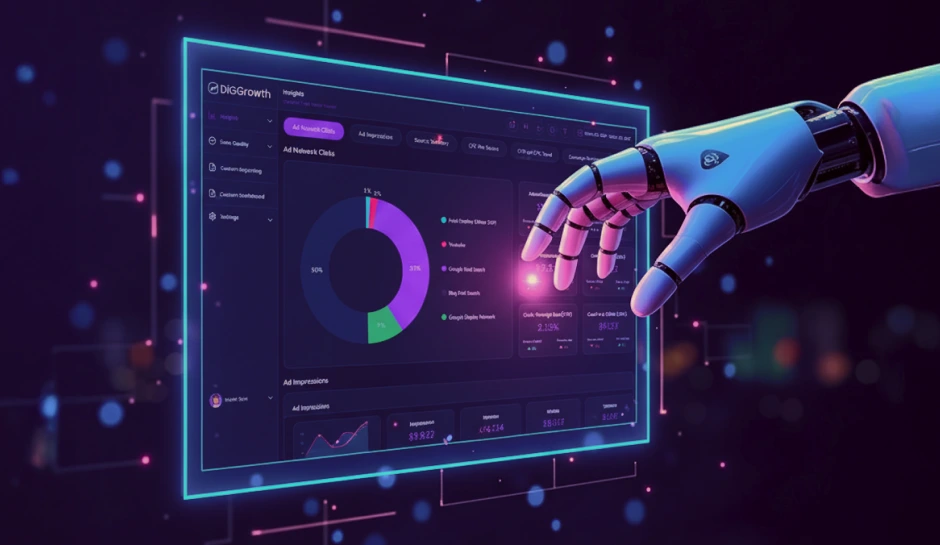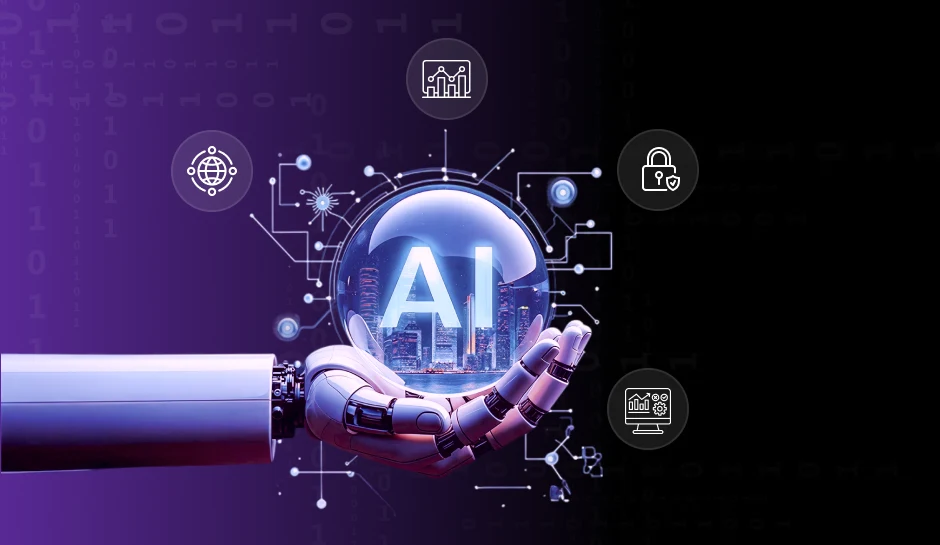Why AI-Powered Ad Performance Tracking Is the Next Big Thing in MarTech
AI-powered ad performance tracking is transforming how marketers manage campaigns by enabling real-time analysis, predictive optimizations, and smarter attribution. This blog explores its core benefits, practical integrations, and real-world use cases across industries.
It is time to stop playing catch-up with your marketing performance.
What if we told you there’s a revolutionary tool about to flip the entire advertising world on its head? Forget everything you thought you knew about managing your ad campaigns. For years, marketers have been trapped in a reactive nightmare, throwing money at campaigns and hoping for the best, only to analyze performance after the damage was done. You have battled data overload, struggled with confusing spreadsheets, and watched your precious budget vanish into the digital void, all while trying to pinpoint what’s actually working. That painful guessing game? It’s over.
Prepare yourself, because the ultimate game-changer has arrived: AI-powered ad performance tracking. This isn’t just an upgrade; it’s the digital marketing cheat code you have been dreaming of. It’s the groundbreaking technology that stops the bleeding, maximizes every dollar, and gives you an unfair advantage over your competition. Get ready, because this is undeniably “the next big thing” in MarTech, and once you see what it can do, you will wonder how you ever survived without it!
What Is AI-Powered Ad Performance Tracking?
AI-powered ad performance tracking is not just another analytics tool. It is a strategic upgrade designed to keep pace with how modern marketing really works: fast, fragmented, and data-heavy.
Instead of simply logging clicks and conversions, this technology uses machine learning to monitor performance in real time, understand what is driving results, and recommend changes before your budget starts bleeding. For instance, a brand running paid campaigns across Instagram, YouTube, and Google Search may notice performance spikes on mobile for one specific creative. AI can instantly detect that pattern, flag the trend, and recommend shifting more budget toward mobile
Why Marketers Are Moving Toward AI-Based Tracking Systems
Marketing today demands precision, speed, and agility across multiple channels. Traditional tracking systems struggle to keep up with this complexity, causing delays and inaccurate insights that hinder campaign success.
AI-powered tracking systems are emerging as the solution marketers need to gain a competitive edge through smarter, faster decision-making.
Challenges Holding Back Traditional Tracking Systems
- Attribution Inaccuracies: It is difficult to accurately identify which ads or channels are driving conversions, leading to inefficient budget allocation.
- Delayed Performance Reporting: Reporting lags by hours or days prevent timely adjustments, causing marketers to miss critical moments for optimization.
- Human Bias in Optimization: Manual data analysis can introduce subjective errors and slow reactions, reducing the ability to spot true performance trends.
How AI-Powered Tracking Addresses These Issues
AI-based tracking systems deliver significant improvements by providing:
- Real-Time Performance Analytics: Instant access to up-to-the-minute data allows marketers to quickly identify what is working and adjust campaigns on the fly, maximizing impact while the campaign is still active.
- Cross-Channel Attribution Powered by Machine Learning: AI integrates data across platforms and devices to create a comprehensive, accurate view of how each channel contributes to conversions, removing guesswork from attribution.
- Smarter Budget Reallocation Based on Outcome Prediction: Predictive models forecast campaign results and automatically shift budgets toward the highest-performing segments, ensuring efficient use of marketing spend and improved return on investment.
Integrating AI-Powered Tracking Into Today’s MarTech Ecosystem
AI in MarTech isn’t just about automating campaigns or personalizing emails. It’s about building an intelligent feedback loop between consumer behavior, content, channels, and ROI, in real-time.
Key Areas Where AI-Driven Tracking Adds Underrated Strategic Value
1. Behavioral Micro-Signals and Pattern Recognition
AI algorithms can identify subtle signals like scroll depth hesitation, cursor stuttering, or interaction delay. These behaviors often reflect indecision, confusion, or interest, far more accurately than traditional metrics.
Traditional tracking fails to interpret such micro-behaviors, but AI models can correlate them with purchase intent or content effectiveness, allowing marketers to adjust user journeys mid-funnel.
Impact: Improved UX, reduced drop-off rates, and more efficient conversion pathways.
2. Predictive Attribution and Path Analysis
Rather than just looking backward at where a user came from, AI models can predict next likely actions across channels. This supports dynamic campaign adjustments, such as shifting ad budgets in real time or triggering personalized content preemptively.
For example, a user exploring tutorials on YouTube after clicking a product ad might trigger a support-oriented follow-up email or demo offer.
Impact: Reduced wasted ad spend, increased ROAS, and tighter alignment between awareness and conversion tactics.
3. Content Performance Forecasting Before Deployment
Using computer vision and NLP, AI can now analyze creative elements color palette, text tone, visual density and predict likely engagement levels based on historical patterns and demographic preference data.
This replaces the expensive and time-consuming reliance on A/B testing alone, reducing both time to market and budget inefficiency.
Impact: More effective creative execution, higher engagement rates, faster iteration cycles.
4. Dark Funnel Visibility
The “dark funnel” refers to the pre-intent behavior occurring in untracked environments, research on Reddit, lurking on forums, social media comments, etc. AI tools can now aggregate and analyze probabilistic data from these spaces to infer intent, even before a user formally enters your funnel.
Without AI, this early-stage intent remains invisible, causing brands to react too late or misalign messaging.
Impact: Earlier targeting, refined audience segmentation, and stronger demand forecasting.
5. Real-Time Experience Shifting
AI can detect in-session behavioral changes, such as declining interest or increased frustration, and automatically adjust the on-screen content, CTA, or UI experience in real time.
For example, if a pricing page shows high bounce rates among mobile Gen Z users, the AI system can serve an alternate layout with simplified language and modern UX within seconds.
Impact: Reduced bounce, higher conversion, and platform adaptability without developer intervention.
How To Integrate AI-Powered Tracking Smartly
- Start With Data Hygiene and Centralization:
- Choose Platforms Built For Openness:
- Test In Phases, Not Big Bangs:
- Equip Teams To Interpret AI Insights:
AI thrives on clean, organized data. Begin by auditing and cleaning your data sources across CRMs, CDPs, and ad platforms. Consolidate fragmented datasets into a single source of truth, which enables AI models to deliver accurate insights and predictions.
Prioritize AI tracking tools with open APIs and native integrations that plug easily into your existing MarTech. Avoid siloed systems that force manual data exports or complex custom coding, this slows down your time to value and creates unnecessary errors.
Roll out AI tracking in stages, starting with one or two key channels. Measure impact, optimize, then expand.
Integration is not just technical. Train your marketing and analytics teams to understand AI-driven recommendations and trust automated decisions. This shift from intuition-based to data-driven marketing demands cultural change.
Pro Tip- In 2025, the brands that win customer loyalty will not just “track” behavior, they will understand it at a granular, predictive level and respond in milliseconds. AI isn’t optional anymore; it’s the only way to keep up with human-level complexity in buyer behavior.
Netflix: How One of The World’s Biggest Streaming Platforms Uses AI To Boost Ad Performance
Netflix is a global streaming giant, attracting millions of viewers daily. Behind its seamless experience lies a sophisticated AI system that transforms how ads are delivered.
How Netflix Uses AI For Ad Optimization
Netflix employs AI technologies to analyze viewer engagement patterns in real time. Instead of placing ads arbitrarily, the system identifies natural pauses or moments when viewers are most attentive. This strategic ad placement minimizes disruption and maximizes ad impact.
According to The Verge, Netflix’s AI-driven system continuously monitors when viewers are most likely to watch ads, such as during scene transitions or less intense moments in content. By focusing on these moments, Netflix reduces viewer frustration and increases ad effectiveness.
The Technology Behind The Scenes
Netflix use of streaming data pipelines combined with AI models. These pipelines process vast streams of live viewing data, capturing second-by-second user behavior. The AI models use this data to:
- Identify the best time slots for placing ads based on predictive analysis.
- Continuously refine campaigns in response to live viewer behavior and engagement patterns.
- Use AI-driven forecasting to boost efficiency and get the most out of every advertising dollar.
This data-driven approach allows Netflix to fine-tune ad delivery continually, creating a seamless and effective advertising experience.
Why Marketers Should Take Note
Netflix’s use of AI-powered ad tracking highlights several key benefits:
- Real-Time Decision Making: Instead of reacting after the fact, Netflix’s system acts immediately on viewer behavior.
- Improved Audience Experience: Ads are better timed and less intrusive, preserving viewer engagement.
- Maximized ROI: By targeting ads when viewers are most receptive, marketers reduce wasted spend and boost campaign results.
Failing to adopt AI-driven tracking means missing out on these advantages. Marketers risk continuing inefficient ad placements, slow optimization, and lower returns in an increasingly competitive digital landscape.
Preparing for the AI-Driven Future of Ad Tracking
As marketing enters a new era driven by real-time data and automation, AI is no longer optional, it’s foundational. DiGGrowth is leading this transformation by helping marketing teams streamline performance tracking, unlock deeper insights, and make every dollar count.
How DiGGrowth Bridges Data and Decision-Making
DiGGrowth equips marketers with tools designed for precision and agility. Its AI-powered Lead Attribution engine traces conversions back to their true origin, helping teams understand which channels and messages are delivering real impact. The Media Mix Modeling solution adds another layer, guiding smarter budget allocation based on historical data and predictive insights. And with DiGGi-GPT, marketers can translate complex analytics into straightforward, actionable strategies in seconds.
Lay the Groundwork for Scalable and Data-Driven Growth
Preparing for the future means building a tech stack that scales with your ambitions. DiGGrowth integrates with major CRMs, CDPs, and advertising platforms, ensuring your data flows seamlessly across systems. This unified view eliminates guesswork, allowing teams to move from reactive campaign management to proactive optimization. In short: fewer blind spots, better decisions, and measurable growth.
Key Takeaways
- AI-powered ad tracking helps marketers act in real-time instead of relying on retrospective reports.
- Tools like DiGGrowth’s Lead Attribution and Media Mix Modeling enable data-backed budget decisions.
- Integrated AI solutions reduce guesswork and improve ROI by identifying high-performing channels.
- Automation eliminates human bias in performance optimization and simplifies campaign adjustments.
- Marketers who adopt AI early gain a strategic advantage in customer targeting and personalization.
Conclusion
Marketing is no longer just about visibility, it’s about intelligence. As customer journeys become more complex and campaign cycles shorten, marketers need more than just data. They need clarity, context, and confidence. That’s exactly what DiGGrowth delivers. With purpose-built AI tools that handle everything from lead attribution to media mix modeling, teams can stop reacting and start predicting. If your current ad tracking system is holding you back, it might be time to upgrade, not just your tools, but your approach to growth.
Are you ready to turn your marketing data into smarter decisions and real impact? Let’s talk.
Our experts at DiGGrowth can help you build an AI-driven performance tracking strategy tailored to your goals and tech stack. Reach out to us at info@diggrowth.com to start optimizing your marketing today.
Ready to get started?
Increase your marketing ROI by 30% with custom dashboards & reports that present a clear picture of marketing effectiveness
Start Free Trial
Experience Premium Marketing Analytics At Budget-Friendly Pricing.

Learn how you can accurately measure return on marketing investment.
Additional Resources
How Predictive AI Will Transform Paid Media Strategy in 2026
Paid media isn’t a channel game anymore, it’s...
Read full post postDon’t Let AI Break Your Brand: What Every CMO Should Know
AI isn’t just another marketing tool. It’s changing...
Read full post postFrom Demos to Deployment: Why MCP Is the Foundation of Agentic AI
A quiet revolution is unfolding in AI. And...
Read full post postFAQ's
AI identifies when audiences begin to ignore or disengage with repeated ads. It then dynamically rotates creatives, adjusts targeting, or pauses underperforming variations to maintain relevance and prevent wasted impressions.
AI tools now prioritize user privacy by working with anonymized datasets and consent-based frameworks. They analyze trends without exposing personal data, helping marketers remain compliant with regulations like GDPR and CCPA.
Yes. AI monitors real-time interaction data across channels, spotting shifts in behavior such as device usage or content preferences, allowing advertisers to adapt strategies before performance declines.
AI continuously analyzes cross-platform performance to reallocate budgets toward high-performing channels. It minimizes manual guesswork by adjusting spend based on live metrics like engagement rate, conversions, and cost per acquisition.
AI processes massive volumes of data instantly, detects hidden patterns, and delivers actionable insights without delays. Unlike manual methods, it reacts in real time, enabling continuous campaign optimization with far greater accuracy.


